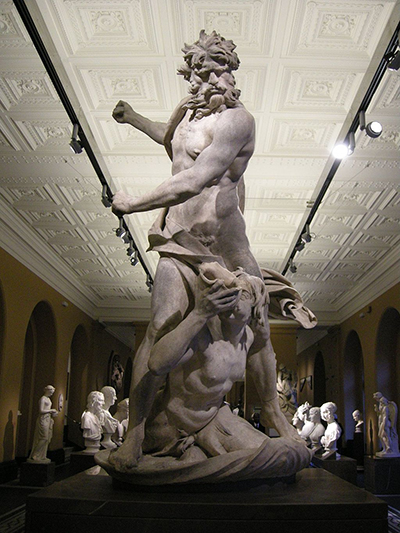Neptune and Triton, a sculpture by Gian Lorenzo Bernini, is housed in the largest museum of decoratives called the Victoria and Albert Museum (Vamp;A) located in London.
It was executed c. 1622 to 1623 and was carved from marble. The sculpture is 182.2 cm in height. In the sculpture, Triton is positioned below the legs of Neptune, and he thrusts himself forward so he can blow the conch shell. He's young, maybe a teenager, with defined musculature. Triton blows his shell, announcing the king of oceans and earth is approaching.
Neptune looks like a 30-year-old man, with wavy locks and beard. His legs are spread apart, and he’s balancing on a big seashell carrying both himself and his son. There is large sheet covering Neptune’s right shoulder, and it’s also gliding in between his strong legs, which reveals parts of the male structure.
The sculpture references the mythological characters of Poseidon (or Neptune) and Triton (his son), protectors of seafarers. Triton and Neptune are deities appearing briefly in classical literature. They are, however, deemed significant as the controllers of the seas and earth. It's a common modern misunderstanding to attribute Neptune to the seas only. However, in the Greek myth, he’s the ruler of earth plus everything it possesses, just like Hades is the known to be the Underworld ruler and Zeus is known to be the ruler of heavens.
Actually, Triton is the character who is attributed to the ruler of the seas only. Neptune and Triton are usually portrayed in water-like setting, and they hold tridents and often driving chariots with horses that shoot out from the water. This sculpture by Bernini gives a somewhat different depiction of the duo.
In Bernini's sculpture, the story depicted was that Neptune is saving the Aenean fleet from fierce seas. Bernini decided to re-interpret the myth and focused on Neptune and Triton responses more than the real story itself. In the actual myth, Neptune is known to come from underneath the seas and splits ships with his trident. The sculptor flipped the scene appearance, with Neptune seen pointing his trident downwards, and he does not make any reference to Aenean fleet, hence giving the impression that Neptune was ruling the sea from above.
Neptune and Triton was originally commissioned by Peretti Montalto, and it served as a fountain for decorating the pond located in the garden of Peretti Montalto (his villa) on the Esquiline Hill, Rome. It was bought by an Englishman called Thomas Jenkins, from whom it was bought later the same year by Joshua Reynolds (a painter). After the death of Reynolds in 1762, Charles Pelham purchased the sculpture and kept it in his home garden in Chelsea, Walpole House. In 1906, his descendants moved it to Brocklesby Park, Lincolnshire (their country house). In 1950, V&A purchased it from the family, although it had appeared at the Royal Academy at an exhibition in 1938.
Bernini gave the viewers the opportunity of seeing the gods in the sculpture in person and in movement. Neptune and Triton sculpture was the first that he worked on where the silhouette was broken, the transitory action climax is given plus where the action is extending beyond the physical limits. Typically, the point of this sculpture is bringing the audience to face a story or myth to be real and true by its amazing dramatic tension seen in the body positions plus subtle hints at a normal, natural life. Bernini was making the stories, rumours and myths a chance to be real and demand observers to really believe in its truth.




